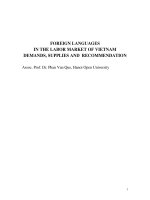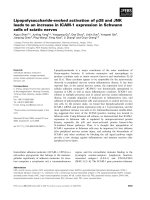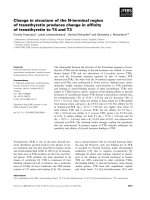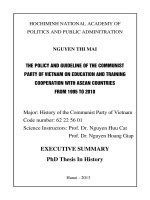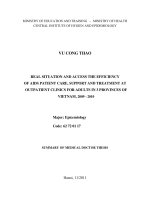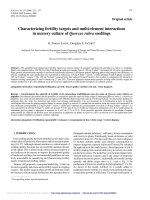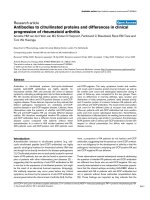Topic 1 differences in culinary culture of the three regions of vietnam north, central, and south
Bạn đang xem bản rút gọn của tài liệu. Xem và tải ngay bản đầy đủ của tài liệu tại đây (10.04 MB, 19 trang )
<span class="text_page_counter">Trang 1</span><div class="page_container" data-page="1">
<b>TRƯỜNG ĐẠI HỌC THƯƠNG MẠI</b>
<b>Topic 1: Differences in culinary culture of the threeregions of Vietnam - North, Central, and South</b>
<b>Giảng viên: Đặng Thị Khánh HàLớp học phần: 232_ENTI1012_74</b>
<b>Nhóm: 8</b>
Hanoi 2024
</div><span class="text_page_counter">Trang 2</span><div class="page_container" data-page="2">1. The characteristics of Northern Vietnamese cuisine...4
1.1 The distinctive features of Northern Vietnamese cuisine...4
1.2 The distinctive dishes of the Northern region...5
2. Central Vietnamese cuisine...7
2.1 The characteristics of Central Vietnamese cuisine...7
2.2 Signature dishes of Central Vietnam...9
3. Southern Vietnamese cuisine...10
3.1 The characteristics of Southern Vietnamese cuisine...10
3.2 Signature dishes of Southern Vietnam...11
4. Similarities in Vietnamese Cuisine Across Three Regions...13
5. Differences in culinary culture of the North, Central and South...15
CONCLUSION...17
</div><span class="text_page_counter">Trang 3</span><div class="page_container" data-page="3"><b>BẢNG ĐÁNH GIÁ THÀNH VIÊN</b>
43 Hoàng Phương Thảo Thành viên <b><sup>- Làm nội dung,</sup></b>powerpoint,
</div><span class="text_page_counter">Trang 4</span><div class="page_container" data-page="4"><b>CỘNG HÒA XÃ HỘI CHỦ NGHĨA VIỆT NAMĐộc lập – Tự do – Hạnh phúcBIÊN BẢN THẢO LUẬN NHĨM</b>
Nhóm: 08
Thời gian: ngày 28/2/2024 Địa điểm: Google meet
Có mặt: 6/6 Vắng: 0 Chủ trì: Trần Ngọc Thảo
Mục tiêu: Tìm hiểu tổng quan về nội dung bài thảo luận, phân tích yêu cầu của bài thảo luận, đưa ra các công việc cần làm và thời gian thực hiện cụ thể cho từng công việc.
Nội dung họp:
1. Nhóm trưởng phổ biến cơng việc, đọc lại nội dung và yêu cầu của bài thảo luận.
2. Đưa ra bảng phân công công việc cụ thể cho từng thành viên. 3. Thông báo thời gian yêu cầu hồn thành cơng việc và lịch lần họp tiếp theo.
<b>NHÓM TRƯỞNG</b>
Thảo Trần Ngọc Thảo
</div><span class="text_page_counter">Trang 5</span><div class="page_container" data-page="5">Vietnamese cuisine, like a symphony of colors, with its unique and captivating melodies, has long been an indispensable part of Vietnamese cultural life. Stretching across the length of the country, from North to South, each region possesses its own distinct culinary characteristics, creating a multi-colored picture that embodies historical, cultural values and even the life philosophies of the Vietnamese people. The cuisine of the three regions, North -Central - South, is like three perfect pieces of a puzzle, contributing to the overall impressive picture of Vietnamese cuisine. Each region and each area carries its own unique characteristics, not only reflected in the way food is prepared and enjoyed, but also hidden within are unique stories and cultural values. Therefore, Group 8 chooses the topic “Differences in culinary culture of the three regions of Vietnam - North, Central, and South” as a research topic. Through this, we will have a deeper understanding of Vietnamese culture, Vietnamese people and the good traditional values that our ancestors have preserved for generations.
<small>3</small>
</div><span class="text_page_counter">Trang 6</span><div class="page_container" data-page="6"><b>1. The characteristics of Northern Vietnamese cuisine1.1 The distinctive features of Northern Vietnamese cuisine</b>
a) Northern Vietnamese cuisine is not heavily seasoned with spices.
While it places importance on the use of spices like the Central and Southern regions, the seasoning style has its own unique characteristics. The dishes of the Northern people have a subtle and refined taste, not overly strong, not too spicy, and often highlight the natural freshness of each ingredient. A notable characteristic of Northern cuisine is the avoidance of intense flavors such as spicy, fatty, or sweet, commonly found in other regions. The dishes maintain a balanced taste, not too overpowering, yet vibrant in color. The cuisine primarily relies on diluted fish sauce, shrimp paste, a variety of vegetables, and freshwater seafood readily available, such as shrimp, crabs, fish, clams, and mussels. Overall, due to ancient traditions and a historically poor
agricultural background, Northern Vietnamese cuisine traditionally had fewer meat-centricdishes.
The traditional meal in the Northern region.
b) The culinary tradition of Northern Vietnam places a strong emphasis on presentation.
Stemming from meticulous and skillful preparation, especially during festive occasions, this artistry becomes even more apparent with elaborately set
<small>4</small>
</div><span class="text_page_counter">Trang 7</span><div class="page_container" data-page="7">tables. Each table must feature a variety of intricately prepared dishes, both delicious and visually appealing, with a customary arrangement of four bowls and six plates. Another distinct characteristic of the Northern region is the tradition of offering gift cakes. These are not necessarily filling dishes but rather simple and rustic gift items like 'bánh cốm' (green rice flake cake), 'bánh cam' (orange sticky rice cake), or various types of preserved fruits. These gifts bring a sense of excitement and nostalgia, preserving cherished memories of the past for the people of the North.
c) The cuisine of Northern Vietnam is rich and diverse.
With Hanoi being considered the epicenter that brings together the essence of Northern culinary excellence. The region is renowned for its signature dishes from the Northeast such as pho, bun cha, bun oc, bun thang, xoi com vong, and banh cuon Thanh Tri, complemented by unique spices like ca cuong essential oil, shrimp paste, and Lang herb. In various other regions, notable specialties include Chiêm Hòa fermented fish sauce, peppermint honey from the Hà Giang mountain forests, field snails, pomelos from Doan Hung, sour meat from Thanh Son, dog meat from Viet Tri, sun-dried tuna in fresh tea, bitter melon wine from Ha Long, fermented glutinous rice wine from Hoanh Bo, and dried sea cucumber, among others.
<b>1.2 The distinctive dishes of the Northern region</b>
a) Pho Ha Noi.
Pho, a culinary masterpiece originating from Hanoi, exemplifies the richness of Northern Vietnamese gastronomy. This iconic noodle soup has transcended its local origins to become a global symbol of Vietnamese cuisine. Hanoi-style Pho is a meticulous blend of delicate rice noodles, immersed in a flavorful and aromatic broth. This broth, the heart of the dish, is crafted through a careful simmering process, infusing it with the essence of choice: beef or chicken, along with an assortment of herbs and spices. The result is a harmonious fusion of textures and tastes that captivates the senses.
What sets Hanoi's Pho apart is not just its exquisite broth and quality ingredients, but also the devotion to detail in its preparation. Thinly sliced beef or tender chicken complements the noodles, creating a symphony of flavors. The bowl is then adorned with a medley of fresh herbs, including cilantro, basil, and bean sprouts, enhancing both visual appeal and aromatic complexity.
Whether enjoyed at a street-side vendor or an upscale eatery, a steaming bowl of Hanoi Pho is a culinary journey, encapsulating the essence of Northern
<small>5</small>
</div><span class="text_page_counter">Trang 8</span><div class="page_container" data-page="8">Vietnamese cuisine. The dish serves as a testament to the region's culinary prowess, showcasing a delicate balance of tradition, innovation, and a deep connection to local culture. In every slurp, one can taste the history and craftsmanship that defines Hanoi's iconic Pho.
Pho Ha Noi b) Braising Fish in Vu Dai Village
Vu Dai Village is renowned for its traditional craft of braising fish, a practice that echoes far and wide. The chosen fish for this specialty are matured catfish, raised for at least three years and weighing over half a kilogram, with some larger specimens exceeding 2 kilograms. Despite its relatively high price, ranging from 500,000 to 1,500,000 VND per pot, Preparing Braised Fish in Vu Dai Village remains consistently sought after, particularly during festive occasions like Tet.
The meticulous preparation of Preparing Braised Fish in Vu Dai Village involves a careful selection of fish and an elaborate cooking process. The chosen catfish are nurtured to maturity, and the braising pot must be made of clay. Cypress wood is the preferred firewood, ensuring a slow and steady cooking process over a wood fire for 13-14 continuous hours. Each step in the preparation, from arranging the fish to selecting the utensils, adheres to precise techniques to prevent any undesirable shifts during the cooking process.
This culinary craftsmanship transforms Preparing Braised Fish in Vu Dai Village beyond a mere dish; it becomes a reflection of the intricate techniques and cultural significance embedded in Northern Vietnamese cuisine. The
<small>6</small>
</div><span class="text_page_counter">Trang 9</span><div class="page_container" data-page="9">village's expertise in the art of fish braising has elevated this dish into a culinary treasure that remains in high demand, especially during festive seasons.
Preparing Braised Fish in Vu Dai Village
<b>2. Central Vietnamese cuisine</b>
<b>2.1 The characteristics of Central Vietnamese cuisine</b>
Central Vietnam is an area with an extreme climate and barren. In this region, people have a preference for bold, salty, and spicy flavors, setting their cuisine apart from both the North and the South.
<small>7</small>
</div><span class="text_page_counter">Trang 10</span><div class="page_container" data-page="10">Stemming from simple, thrifty, the Central region especially enjoys rich salty flavors in daily meals. Some Central provinces, such as Hue, Da Nang, Binh Dinh are famous for many types of fish sauce: mắm nêm, fish sauce, sour shrimp sauce, shrimp sauce, anchovy sauce... A fun fact for you: Central people drink sugarcane juice mixed with an abundance of sea salt.
The penchant for spicy food in Central Vietnam finds its roots in historical influences. In the 14th century, the Việt from the North came to the Central and lived together with the Cham people. They learned the Cham people's tradition of eating chili. Spicy chili peppers have helped them cope with nature, withstand the cold. In addition, chili helps make the fish sauce dishes of the Central region less fishy. What's fascinating is the method of incorporating chili into dishes; instead of chopping or slicing, it's often crushed and mixed directly into sauces, gradually becoming an integral component of the region's culinary identity.
But the highlight when it comes to Central cuisine, people will clearly see that this place has two different flavors, one is folk cuisine, and the other is Hue Royal cuisine.
There are many rules in cooking Hue cuisine, from the provision of food, processing, serving, table setting, and so on. All royal dishes must be carefully and beautifully decorated and follow the rules of neatness, colors, harmony. Among the most precious are the 'Eight Royal Dishes,' which include royal nem, phoenix sausage, buffalo skin, bear paw, deer tendon, pangolin lips, elephant foot meat, and swallow's nest.
<small>8</small>
</div><span class="text_page_counter">Trang 11</span><div class="page_container" data-page="11">Different from the magnificent and luxurious lifestyle shown in Hue royal cuisine, the rustic cuisine on the South Central Coast always makes the taster feel the industriousness, thriftiness and frugality of the people of the Central region. Typical dishes of rustic cuisine: Bún bò, nem chua, mì Quảng, bánh xèo, bánh bột lọc, cơm hến,...
<b>2.2 Signature dishes of Central Vietnam</b>
The people of Central Vietnam always know how to make the most of the abundant resources of their homeland to create distinctive dishes that leave a lasting impression on diners. They have cultivated a unique and diverse culinary scene. Allow me to introduce you to two emblematic dishes: fermented shrimp paste (mắm nêm) and sour fermented shrimp (tôm chua).
Mắm nêm
<small>9</small>
</div><span class="text_page_counter">Trang 12</span><div class="page_container" data-page="12">Mắm Nêm: Mắm nêm is a traditional Vietnamese fermented fish paste that originates from Central Vietnam. It is a common fixture in the meals of Central Vietnamese people and often used as a dipping sauce for various dishes or incorporated into traditional Vietnamese recipes to enhance the flavor. It is made from various ingredients such as fermented fish, shrimp, or crab, combined with spices, garlic, sugar, and chili. Mắm nêm has a pungent aroma and a complex flavor profile, balancing salty, sweet, sour, and spicy notes.
Tôm Chua: Tôm chua, or sour shrimp, is my favorite Central dish known for its unique sour and savory taste. Tôm chua is often served as an appetizer or snack, accompanied by fresh herbs, vegetables, and rice paper for wrapping. It is made by marinating fresh shrimp in a mixture of vinegar, lime juice, sugar, salt, garlic, and chili. The shrimp absorb the tangy marinade, resulting in a refreshing and flavorful dish.
Tôm chua
These two dishes contribute to expressing the rich culinary heritage of Central Vietnam. I hope you have a chance to enjoy these 2 dishes.
<b>3. Southern Vietnamese cuisine</b>
<b>3.1 The characteristics of Southern Vietnamese cuisine</b>
Southern Vietnam is a land rich in fertility, abundantly blessed by nature with lushness and richness. The cuisine of the Southern region is diverse and abundant, carrying a sense of freedom and wilderness due to the generous and abundant nature of the region's rivers and deltas. Southern cuisine is a harmonious blend of Northern and Central culinary cultures, along with influences from Khmer culture.
<small>10</small>
</div><span class="text_page_counter">Trang 13</span><div class="page_container" data-page="13">A prominent feature of the Southern palate is its distinctive sweetness. Sugar becomes an essential seasoning for the people here. The Southern palate tends towards richness, with each flavor distinct and pronounced. On the other hand, the salty taste in the local cuisine comes from the rich flavor of pure fish sauce, while the intense spiciness arises from various types of chili that can bring tears to your eyes. Moreover, there are dishes with sweet, rich flavors that tantalize the palate, sourness that wrinkles the face, or bitterness that can overwhelm.
In addition to its unique palate, Southern cuisine also carries within it wild characteristics. When catching something, they can cook and eat it immediately on the spot to ensure freshness. Over time, these rustic traits have become fascinatingly unique features of Southern cuisine.
<b>3.2 Signature dishes of Southern Vietnam</b>
a) Lẩu mắm
One dish that stands out and is an absolute must-try when visiting the Southern region is Lẩu mắm, a quintessential representation of the savory essence of this watery region.
The broth for this dish is meticulously crafted from fish sauce derived from the distinctively flavorful fish found in the rivers and deltas of the region. This fish sauce serves as the foundation for a rich and complex broth that is both aromatic and deeply savory. It forms the perfect base for an array of delectable ingredients, including an assortment of fresh seafood such as shrimp, fish, squid, and crab, as well as an abundance of locally sourced vegetables and herbs.
As the hotpot simmers, the flavors mingle and meld together, creating a symphony of tastes and textures that tantalize the palate. The sweetness of the seafood, the earthiness of the vegetables, and the umami-rich essence of the fish sauce all come together harmoniously in each spoonful.
<small>11</small>
</div><span class="text_page_counter">Trang 14</span><div class="page_container" data-page="14">Lẩu mắm b) Cá lóc nướng trui
Grilled snakehead fish is unquestionably a signature delicacy of the Southern region of Vietnam. The snakehead fish, sourced from the rice fields, undergoes a meticulous preparation process that involves absolutely no seasoning. Instead, it is treated with care and expertise before being skewered onto bamboo sticks. These skewers are then carefully nestled within dry straw and set to grill over an open flame until perfectly cooked.
The cooking method imparts a unique smoky flavor to the fish while ensuring that it remains succulent and tender on the inside. Once cooked to perfection, the outer charred skin is gently scraped away, unveiling the delicate, moist flesh within. This meticulous process not only enhances the flavor but also showcases the skill and dedication of the local chefs.
The grilled snakehead fish is typically served as a communal dish, encouraging diners to come together and share in the experience. One popular way to enjoy it is by wrapping the tender fish in rice paper along with an assortment of fresh vegetables, herbs, and vermicelli noodles. This medley of flavors and textures creates a delightful harmony with each bite.
<small>12</small>
</div>